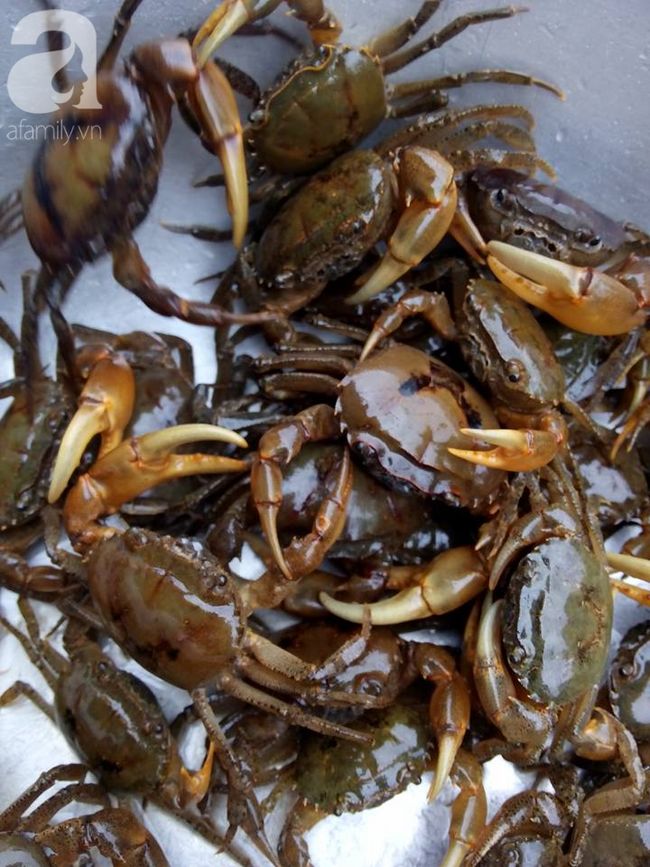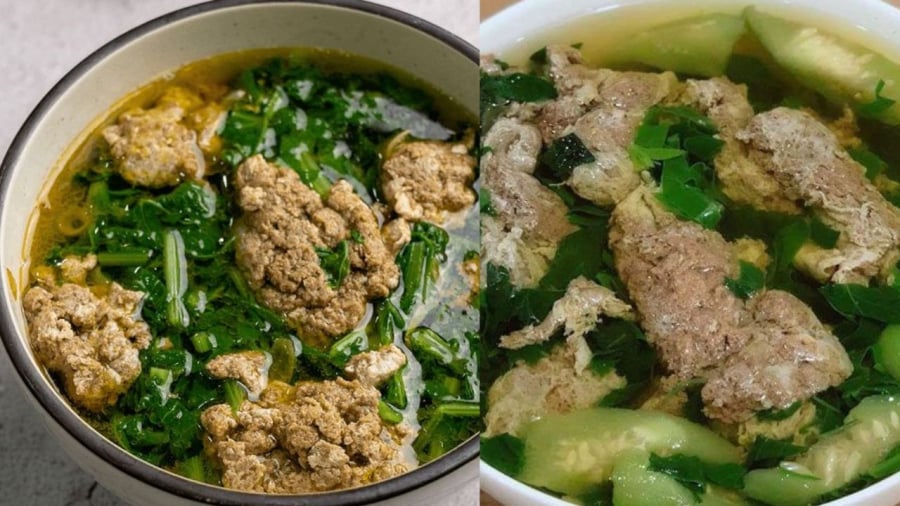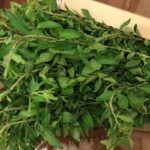Crab soup is a humble yet beloved dish in Vietnamese cuisine, especially during the sweltering summer days. A well-prepared bowl of crab soup should have clear broth, with crab meat floating in chunks, offering a refreshing and uniquely fragrant taste. However, not everyone knows the secrets to keeping the meat intact, preventing the broth from turning cloudy or acquiring a fishy smell. Here are some time-tested tips and tricks passed down from generations of home cooks and seasoned housewives to prepare delicious crab soup.
1. Choosing fresh river crabs as the key to a delectable soup
Selecting quality ingredients is paramount to preparing authentic crab soup. Opt for fresh, live river crabs with a dull gray or slightly yellow hue. Female crabs tend to have more roe, while males offer more meat; choose according to your preference. However, river crabs are sweeter and more aromatic than their farmed counterparts.
Pro tip: Go for crabs with flat flaps, indicating they haven’t carried eggs, and opt for those with shiny shells and quick movements, ensuring they are lively and have all their limbs intact. Avoid crabs with a pungent odor, weak movement, or those that have died or are soft and squishy.

2. Proper cleaning ensures a clear, odorless broth
Once you’ve selected quality crabs, thorough cleaning is essential to achieving a clear and odor-free broth. Here’s how:
- Soak the crabs in diluted saltwater or rice washing water for 15–20 minutes to remove any mud or dirt.
- Separate the shells and set the roe aside. Use a small brush to scrub the body and legs or vigorously shake them to ensure cleanliness.
- Rinse multiple times with clean water until the water runs clear.
Note: When handling the roe, be gentle to avoid breaking the small green bile sac located inside the shell, as this will make the soup bitter.
3. A traditional technique for chunkier crab meat
A time-honored technique to achieve chunkier crab meat that floats to the surface of the soup is to hand-pound the crab instead of using a machine. Hand-pounding helps release more of the natural glue in the crab meat, resulting in larger, more aesthetically pleasing chunks.
Add a pinch of salt while pounding or blending the crab to help bind the meat together. After achieving a smooth consistency, add filtered water, stir well, and strain the mixture through a fine-mesh sieve.
Repeat the straining process 2–3 times to ensure all the meat is extracted, then let the crab water settle.

4. Simmer over medium heat, stirring gently
When cooking the soup, refrain from vigorous stirring, as it can cause the crab meat to break apart and prevent it from forming chunks. Here’s the correct method:
Place the crab water in a pot on the stove, turn the heat to medium, and give it a gentle stir. Once the crab meat starts to coagulate and rise to the surface, reduce the heat to low and continue cooking for a few minutes to ensure even cooking.
To maintain clarity, leave the lid off during cooking, and refrain from seasoning at this stage, as salt or fish sauce may interfere with the coagulation process.
5. Sautéing the roe enhances flavor and color
While waiting for the crab water to boil, you can sauté the roe to enhance the soup’s flavor and appearance. This step adds a golden sheen and a distinctive aroma to the dish. Heat a small amount of cooking oil (or lard for a richer flavor), add dried shallots, and sauté until golden brown. Then, gently stir in the roe.
When the crab meat has formed chunks and is floating on the surface, carefully pour in the sautéed roe without stirring vigorously.
6. Complementary vegetables enhance the sweetness of the crab
Crab soup is traditionally paired with humble vegetables like spinach, malabar spinach, ridged gourd, or young mustard greens. These vegetables not only add variety to the dish but also help cool the body and aid digestion. Here’s how to select the best vegetables:
- Spinach: Opt for spinach with small stems and deep green leaves, avoiding older, tougher leaves.
- Malabar spinach: Choose young shoots with round, shiny, and plump leaves.
- Ridged gourd: Use either ridged gourd or its close cousin, the smooth luffa, peeling them thinly and cutting them into wedges.
Add the vegetables to the pot once the soup is ready and let it simmer for 1–2 minutes before turning off the heat. Season to taste with salt, good-quality fish sauce, and a touch of MSG, if desired.
7. Final tips for a perfect bowl of crab soup
- Avoid cooking crab with sour vegetables like tamarind or bottle gourd, as they can make the meat mushy and fishy.
- When diluting the crab meat, use filtered water or cooled boiled water instead of very cold water.
- Use a thick-bottomed, non-stick pot to prevent the crab meat from sticking and burning.
With these tips and tricks, you’re well on your way to preparing an authentic and delectable crab soup: chunky crab meat, crystal-clear broth, a subtle sweetness, and tender vegetables. This dish is not only a perfect summer cooler but also a great source of calcium, protein, and essential nutrients for your family. Give it a try and experience the difference!
From Weeds to “Liver-Cooling Delicacy”: Still Sold Out in the City at 75,000 VND per kg
“Once dismissed as a mere weed, this plant is now a sought-after delicacy in urban areas. With its unique bitter-sweet taste, the ‘Rau Cu Khoi’ vegetable is not only delicious but also packed with nutrients. A true gift that keeps on giving, it can be harvested year-round with just a single planting.”
The Best Bun Cha Ha Noi Has to Offer: 5 Mouth-Watering Destinations Worth the Splurge
When in Hanoi, indulging in a bowl of authentic bun cha is a must. This iconic Vietnamese dish, a harmonious blend of grilled pork, savory broth, and delicate rice noodles, is elevated to perfection at these five renowned establishments. Though they may come at a higher price, the exquisite flavors and exceptional dining experience are well worth the splurge. Prepare your taste buds for a culinary journey like no other!






































